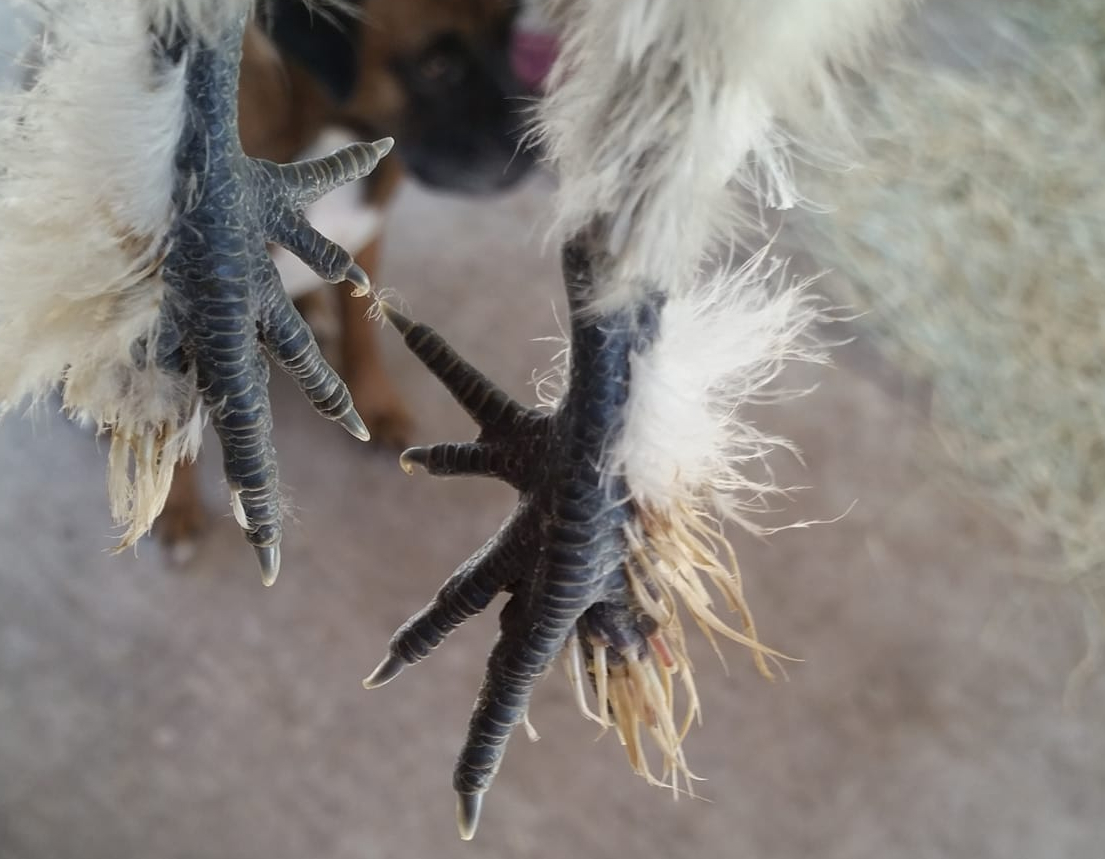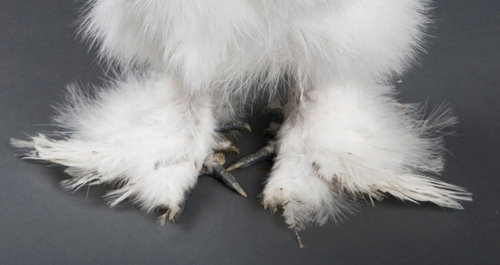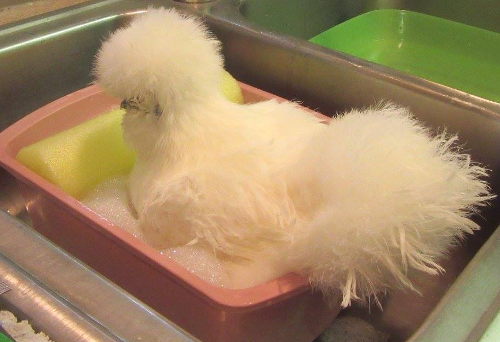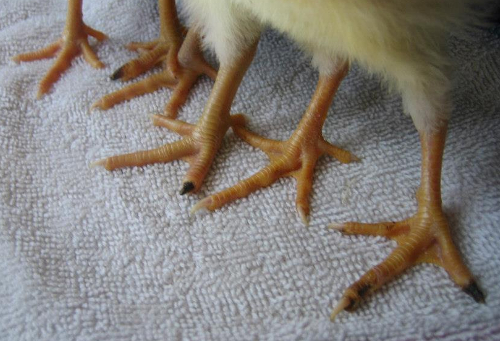Looking after a Silkies feet. Common problems and treatment.

A Silkie chickens feet:
You will notice something a little different about Silkie chickens feet. It is a perfectly normal trait in Silkie chickens to have one extra toe, sometimes more. This, coupled with them being a feathered leg and foot type means they suffer more than their fair share of foot problems.
Below: A good example of Silkie feet. Clean and well feathered with straight toes and short nails or claws.

It's more desirable to have feathers on all 5 toes but at a minimum to the third toe especially if you want to show them. I would never breed a Silkie with 4 toes, same goes for a single comb bird, or 6 toed bird. Yes, you will get some chicks that have the right amount of toes or comb, but the chicks will also carry that bad gene and it will keep coming up later on down the line in when you breed.
Should you clean a Silkie chickens feet?
From time to time it is necessary to clean a Silkies feet even if you are not showing them. Mine are always fine in the summer but in the wet and cold of winter they need a little extra care.
Washing Silkies too often can be as much of a problem as not cleaning at all.
If your Silkies are kept in a dry covered run that doesn't get muddy or wet then a quick inspection of the feet every few weeks or so will be fine. Only do it if you have to otherwise it is a waste of time.
How to clean Silkies feet:
They get mucky in the winter but generally sort themselves out in the summer. I don't wash my birds. They dust bath as nature intended.
Below: If you get calm birds and the correct water temp of 35 C or 95 F Silkies quite like having a bath.

Soak the feet in the bathtub for at least 30 minutes then wash. Use a toothbrush to scrub if necessary. Rinse properly.
Dealing with long nails:
A chickens with long nails needs to have them trimmed so as they sit properly. They should wear them down evenly if they are allowed to scratch in the dirt but sometimes they need a helping hand.
In this image you can see that most of the Silkies nails sit flat and point straight out of the end of the toe. The inside pair have got a little long and have started to turn sideways. These two need the tip trimming to ensure they get back to normal. Remove about the end 25% or one quarter, avoiding the quick or blood supply and file to remove any sharp edges.
Also the Nails on the extra toes sometimes point upwards meaning they get no wear at all. These should be trimmed regularly and filed to remove the sharp points.
Scaly leg mite:
Scaly leg mites are microscopic parasites that burrow under the scales of the legs and toes.
I dip legs, even with feathers on the feet, in a cup of mineral oil (veg oil will work too) every day for 2 weeks. Treat coop with permethrin dust or spray, toss bedding and nesting material. My thoughts on the feathers getting oily is that it is more important to worry about getting rid of the mites.
The 2 week treatment is necessary due to the life cycle of the mites. It can attack the comb as well, so you can put some oil there also. I would also do a dusting of the chickens with poultry dust (permethrin), dusting the vent area and under the wings (everywhere but the face) and be sure to repeat at 7 days for mites and 14 days for lice to break the life cycle. (Treat the coop and toss bedding with each treatment.)
Next, get some Vaseline. You are going to gently rub this all over the scales to help soften them and this will also smoother the mites as well. Never pick at these crusts as they will bleed. Just let them fall off naturally. You will need to apply the Vaseline every day to every other day for several weeks if not a month or more, depending. So don't expect over night improvement with this. Be patient.
Spray your roost bar down with some sort of poultry or permethrin spray. Make sure to get under the bar as well. Diatomaceous earth is excellent for this long term treatment as it works well on contact over time.
These mites travel fairly slowly from bird to bird, but keep an eye on the rest of your flock. You might give them all one dosage of the Ivermectin pour on as well.
Finish with some Ivermectin pour on for cattle if you need to. This may or may not be legal depending on where you are in the world and you might need a prescription for it. There is also some serious egg withdrawal time associated with chemical treatment.
Depending on how big your Silkie is, the dosage is generally 6 drops for large breeds, 3 drops for Bantams. So I would imagine your Silkie falls somewhere in between these. Get a medicine dropper and you are going to pull back the feathers on the back of the neck and drop 4 or 5 drops on the skin only. This stuff is useless on feathers, so make sure it hits the skin. I find it is easy to do this if you towel up the bird and lay them in your lap. And because this situation is so severe, you may need to repeat this dosage every 7 to 10 days for about a month.
Keeping your Silkies feet in good condition:
- Check the feet regularly and do not allow them to become caked in mud or poop.
- Use rounded perches that have been smoothed off with no rough edges.
- Move the flock to fresh ground as grass is better than hard packed mud.
Silkies and bumble-foot:
Pretty easy to treat in the early stages. But wear gloves if touching and soak it in warm water and Epsom salt for 30 mins. It'll make it easier to clean out. I use tweezers to pull out and bandage up after make sure it stays clean because it takes a while to heal.
Bumble foot can be a problem. There's a kernelor cyst that needs to come out before it heals properly and wrap every day till healed, I took mine to a vet to learn how to do it as it can become a serious issue if you don't get it treated straight away.
Frostbite in Silkies feet:

